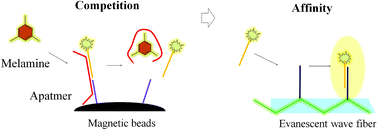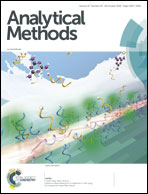Aptamer-based detection of melamine in milk using an evanescent wave fiber sensor†
Abstract
Rapid detection of melamine has been achieved in past studies to support the quality control of milk and formula products. Aptamer-based biosensors are a promising choice for melamine analysis due to their advantages over instrumental analysis and immunoassays. A long-chained aptamer with 88 nucleotides has been validated for its recognition of melamine. However, signal conversions of such aptamers have not been sufficiently explored for the purpose of their application in practice. Here, in order to extend the feasibility of detecting melamine using aptamers, we attempted to use an aptamer-based evanescent wave fiber (EWF) sensor to quantify melamine in milk. The duration of the analytical procedure was about 17 min. The calibration curve was interpreted by the dual-log function in the range from 0.1 to 20 μM. The limit of detection (LOD) of melamine was 0.15 μM in the buffer and 3.0 μM in milk. The selectivity of the method to melamine was verified using analogues such as cyanuric acid, ammelide, and ammeline. The recovery rates of melamine in liquid milk ranged from 92% to 108%, and the relative standard deviations were less than 7.5%. Thus, aptamer-based EWF sensing is a feasible method to detect melamine in milk.



 Please wait while we load your content...
Please wait while we load your content...